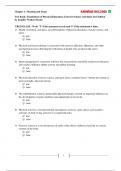MEDGEEK
Chapter 1: Meaning and Scope Answers Included
Test Bank: Foundations of Physical Education: Exercise Science and Sport 21st Edition
by Jennifer Walton-Fisette
TRUE/FALSE - Write 'T' if the statement is true and 'F' if the statement is false.
1) Health, recreation, and dance are subdisciplines of physical education, exercise science, and
sport.
⊚ true
⊚ false
K
2) Physical activity psychology is concerned with exercise addiction, adherence, and other
psychological issues affecting the well-being of people who are physically active.
⊚ true E
⊚ false
3) Sport management is concerned with how the characteristics and skills of physical educators
E
and coaches influence athlete activity and athlete learning.
⊚ true
⊚ false
G
4) Physical education, exercise science, and sport share a common focus—human movement or,
more generally, physical activity.
⊚ true
⊚ false E D
5) The rehabilitation sciences, particularly physical therapy, exerted an important influence on
the development of sports medicine and adapted physical activity.
⊚ true
⊚ false
M
6) Physical activity is a broad term that encompasses exercise, sport, dance, active games,
activities of daily living, and active occupational tasks.
⊚ true
⊚ false
7) Exercise science is a very broad area of study of the effects of physical activity on various
systems of the body.
⊚ true
⊚ false
1
, MEDGEEK
8) Health instruction educates people about health in many areas, including disease prevention,
mental health, nutrition, physical fitness, stress management, and dealing with abuse of drugs
and alcohol.
⊚ true
⊚ false
9) Qualitative research answers questions through words, images, and sounds.
⊚ true
⊚ false
10) Proper nutrition helps professionals stay abreast of new developments in the field, facilitates
K
communication among professionals, and plays a role in professional activities such as
teaching, assessment, and research.
⊚ true
⊚ false
E E
11) All populations have equal participation rates in physical activity.
⊚ true
⊚ false G
MULTIPLE CHOICE - Choose the one alternative that best completes the statement or
answers the question. D
12) Settings for physical education programs include all of the following except
A) community settings.
B) medical settings. E
C) school settings.
D) commercial settings.
E) None of the answers are correct.
M
13) The text states that all of the following factors influence physical activity levels except
A) educational attainment.
B) height.
C) ethnicity.
D) age.
E) economic status.
2
, MEDGEEK
14) Sports medicine is concerned with
A) injury prevention.
B) the study of skill acquisition.
C) the study of the impact of exercise on the body.
D) activity programs for people with disabilities.
15) Which of the following disciplines of physical education, exercise science, and sport deals
with an athlete's gait analysis?
A) sport philosophy
B) exercise physiology
C) sport biomechanics
K
D) motor development
16) is the study of the role of sport in society, its impact on participants in sport, and the
E
relationship between sport and other societal institutions.
A) Sport philosophy
B) Sport psychology
C) Sport sociology
D) Sport pedagogy
E
17)
G
refers to well-established, officially governed competitive physical tasks in which
participants are motivated by internal and external rewards.
A) Sport
B) Physical activity
C) Exercise E D
D) Physical fitness
18) Exercise physiology is the study of
objects.
M
A) the methods of physics and mechanics used in human motion and the motion of sport
B) the effects of various physical demands on the structure and function of the body.
C) activity programs for the people with disabilities.
D) the mechanical analysis of motor skills.
19) studies the factors that influence the acquisition of abilities essential to movement.
A) Motor development
B) Adapted physical activity
C) Sport pedagogy
D) Biomechanics
3
, MEDGEEK
20) Which of the following disciplines is concerned with the study of the structure of knowledge
in sport, ethical and moral questions, and the aesthetics of movement?
A) sport philosophy
B) sport history
C) sport sociology
D) sport biomechanics
21) Identify a true statement about exercise physiologists.
A) Clinical exercise testing is not an area of responsibility of exercise physiologists.
B) Exercise physiologists focus exclusively on the mechanisms that can reduce disease
progression in athletes.
K
C) Exercise physiologists are concerned with both acute and chronic adaptations of the
various systems of the body to exercise.
D) Design of rehabilitation programs for postcardiac patients is not one of the
E
responsibilities of exercise physiologists.
E
22) Which of the following is true of physical fitness?
A) It requires participants to be motivated by internal and external rewards.
B) It is a measure of the application of science to the study of physical activity.
performed.
G
C) It helps measure the duration, frequency, and intensity of an exercise being
D) It is a state of well-being associated with low risk of premature health problems.
23) Unlike quantitative research, qualitative research
A) is based exclusively on frequency counts. E D
B) describes, correlates, predicts, or explains a hypothesis posed at the beginning of a
study.
C) answers questions through words, images, and sounds.
M
D) is based on numbers, primarily the statistical analysis of the gathered numeric data.
SHORT ANSWER. Write the word or phrase that best completes each statement or
answers the question.
24) In the text, physical education, exercise science, and sport are defined as one field. In today's
society, should they be collectively considered as one field or separately as multiple fields?
Explain. What factors can you use to support your stance?
4




